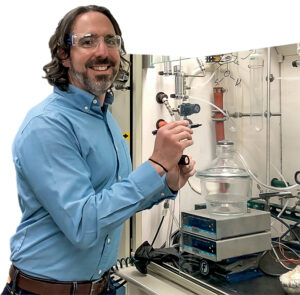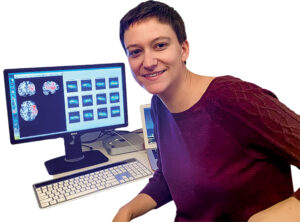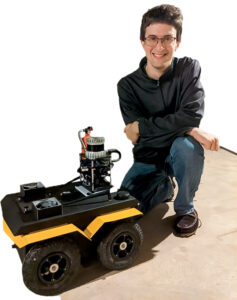STEM Stars
Christine Thomas ’01
Fox Professor and vice chair of graduate studies, Department of Chemistry and Biochemistry, Ohio State University
 Thomas loves being at the forefront of scientific discovery, where every day offers an opportunity to push the boundaries of contemporary chemical knowledge. She researches the design of catalysts that can enable reactions to transform naturally abundant resources such as hydrocarbons and carbon dioxide into useful fuels and chemical feedstocks. “I love working on projects that tackle big problems and could have a global impact, but what motivates me the most is that along the way, we get to have a lot of fun making fundamental scientific discoveries,” she says. “Almost every transition metal compound my students make is something that no one else in the world has ever made before, allowing us to uncover new properties and sometimes even new concepts that can’t be found in textbooks.” She says skills she developed in Lafayette labs are the foundation of her research today.
Thomas loves being at the forefront of scientific discovery, where every day offers an opportunity to push the boundaries of contemporary chemical knowledge. She researches the design of catalysts that can enable reactions to transform naturally abundant resources such as hydrocarbons and carbon dioxide into useful fuels and chemical feedstocks. “I love working on projects that tackle big problems and could have a global impact, but what motivates me the most is that along the way, we get to have a lot of fun making fundamental scientific discoveries,” she says. “Almost every transition metal compound my students make is something that no one else in the world has ever made before, allowing us to uncover new properties and sometimes even new concepts that can’t be found in textbooks.” She says skills she developed in Lafayette labs are the foundation of her research today.
Dan Ruddy ’03
Researcher at National Renewable Energy Laboratory
 Electric vehicles are on the rise, but a portion of the transportation sector will continue to rely on liquid fuels for some time. Ruddy is developing new chemical processes for the conversion of biomass and similar waste carbon sources into renewable versions of the fuels we use today. “The renewable processes we seek to develop can reduce greenhouse gas emissions by more than 60%, and often more than 80%, compared to typical fossil-derived fuels,” he says. Ruddy says his STEM education at Lafayette “set the rock-solid foundation” that has supported his career.
Electric vehicles are on the rise, but a portion of the transportation sector will continue to rely on liquid fuels for some time. Ruddy is developing new chemical processes for the conversion of biomass and similar waste carbon sources into renewable versions of the fuels we use today. “The renewable processes we seek to develop can reduce greenhouse gas emissions by more than 60%, and often more than 80%, compared to typical fossil-derived fuels,” he says. Ruddy says his STEM education at Lafayette “set the rock-solid foundation” that has supported his career.
Meghan Caulfield ’06
Mendel Science Fellow in Department of Psychological and Brain Sciences, Villanova University
 Anxiety disorders are the most common mental illnesses in the United States, but little is known about why some people develop them and others do not. Caulfield is determined to help find answers. “My research tries to understand the cognitive factors that contribute to risk for anxiety. I look for differences in attention, learning, and memory by comparing people with personality types that place them at greater risk for anxiety with those who are more resilient to anxiety disorders.” Caulfield then links those differences to neural activity through the use of noninvasive brain imaging methods. She says the opportunity to engage in research at Lafayette as an EXCEL Scholar prepared her for graduate research. “I gained crucial experience developing independent research with mentors through advanced research opportunities.”
Anxiety disorders are the most common mental illnesses in the United States, but little is known about why some people develop them and others do not. Caulfield is determined to help find answers. “My research tries to understand the cognitive factors that contribute to risk for anxiety. I look for differences in attention, learning, and memory by comparing people with personality types that place them at greater risk for anxiety with those who are more resilient to anxiety disorders.” Caulfield then links those differences to neural activity through the use of noninvasive brain imaging methods. She says the opportunity to engage in research at Lafayette as an EXCEL Scholar prepared her for graduate research. “I gained crucial experience developing independent research with mentors through advanced research opportunities.”
Ian Miller ’18
Ph.D. candidate in electrical and systems engineering, University of Pennsylvania
 Can a robot think about its environment? Can it perceive its location and what its surroundings look like? These are some of the questions Ian Miller is researching. Miller’s research has significant implications for mapping dangerous and hostile environments, and keeping humans out of harm’s way. “Maybe it’s some kind of natural disaster, or there’s some kind of armed conflict that you don’t want to send people into. So now you can send in this team of robot drones that are flying around overhead and also ground robots that can look into buildings,” he says. Miller says Lafayette prepared him for research at Penn. “You never got pigeonholed in one area; you were always encouraged to explore and experiment with new ideas,” he says.
Can a robot think about its environment? Can it perceive its location and what its surroundings look like? These are some of the questions Ian Miller is researching. Miller’s research has significant implications for mapping dangerous and hostile environments, and keeping humans out of harm’s way. “Maybe it’s some kind of natural disaster, or there’s some kind of armed conflict that you don’t want to send people into. So now you can send in this team of robot drones that are flying around overhead and also ground robots that can look into buildings,” he says. Miller says Lafayette prepared him for research at Penn. “You never got pigeonholed in one area; you were always encouraged to explore and experiment with new ideas,” he says.
Read more about Lafayette STEM Stars at bit.ly/STEM-stars